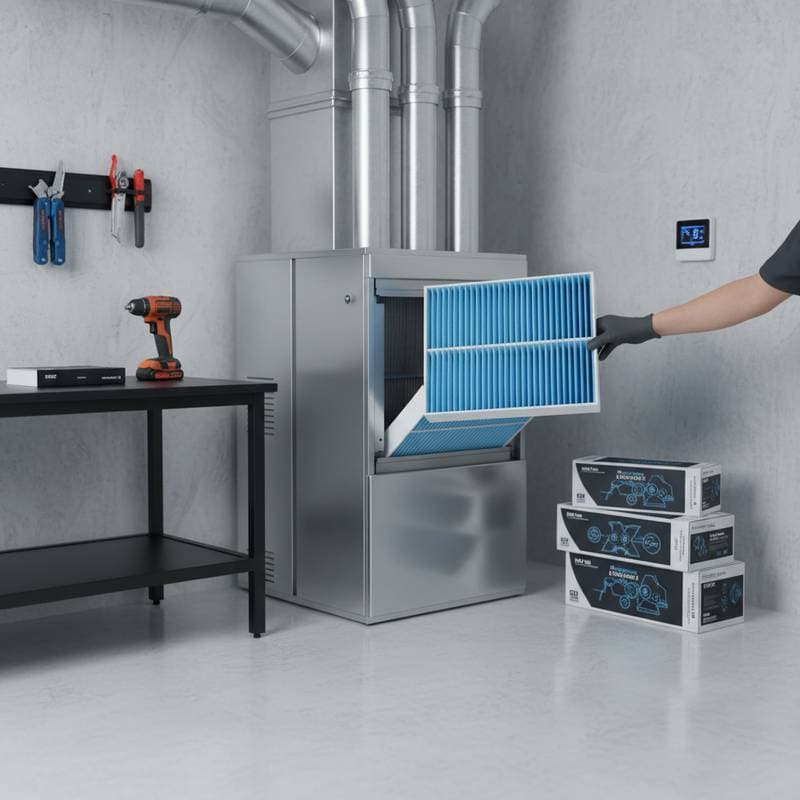7 Spring Tasks to Keep Your AC Running Smoothly Through Summer
Air conditioners face their greatest demands during summer months, which makes spring an ideal period for preparation. Simple maintenance actions enhance system efficiency, reduce energy consumption, and minimize the risk of unexpected failures. A structured spring routine positions the unit for optimal operation as temperatures rise.
Quick Spring AC Maintenance Checklist
| Task | Purpose |
|---|---|
| Replace or clean the air filter | Improves airflow and energy efficiency |
| Clear debris around the outdoor unit | Prevents airflow blockages |
| Inspect the thermostat settings | Ensures accurate temperature control |
| Check vents and registers | Promotes balanced airflow |
| Clean the evaporator and condenser coils | Boosts cooling performance |
| Test system operation | Identifies early performance issues |
| Schedule a professional tune-up | Confirms system safety and efficiency |
1. Replace or Clean the Air Filter
A clogged air filter ranks among the primary reasons for diminished AC performance. Accumulated dust and particles hinder airflow, compelling the system to exert extra effort to distribute cooled air throughout the residence. At the onset of spring, install a new disposable filter or wash a reusable one thoroughly. During the cooling season, inspect the filter each month to sustain consistent airflow and alleviate undue stress on the equipment.
2. Clear Debris Around the Outdoor Unit
The outdoor condenser unit requires unobstructed access to function effectively. Accumulated leaves, grass clippings, or encroaching vegetation can impede airflow and compromise operational efficiency. Maintain a clearance of at least two feet surrounding the unit, prune adjacent plants, and eliminate any debris buildup. This practice supports adequate air circulation and guards against overheating during intense usage periods.
3. Inspect and Calibrate the Thermostat
An inaccurately calibrated thermostat may trigger excessive cycling or result in inconsistent cooling across the home. Verify accuracy by comparing the thermostat reading with that of a separate indoor thermometer. In cases of discrepancy, adjust the calibration or consider replacement. Upgrading to a programmable or smart model allows for customized cooling schedules, which further optimizes energy usage.
4. Check Vents and Registers
Obstructed or sealed vents lead to imbalanced cooling and added strain on the system. Conduct a walkthrough of the home to confirm that all supply and return vents remain open and free from blockages caused by furniture, carpets, or draperies. Remove dust accumulation from vent covers using a vacuum to enhance indoor air quality and facilitate smoother circulation. Even distribution of airflow enables the AC to maintain uniform temperatures in every room with greater efficiency.
5. Clean the Evaporator and Condenser Coils
Dirt and residue gradually accumulate on the evaporator and condenser coils, impairing the unit's ability to transfer heat effectively. This contamination diminishes cooling capacity and increases energy demands. Access the indoor evaporator coil within the air handler and clean it gently with a soft brush or specialized coil cleaner. For the outdoor condenser, detach the fan guard and rinse the fins using a low-pressure garden hose. Well-maintained coils promote superior cooling while conserving energy.
6. Test System Operation
Prior to the arrival of summer, activate the AC and allow it to complete a full operating cycle. Monitor for atypical sounds, evaluate airflow strength, and verify that chilled air emerges from the vents. Observe for short cycling, in which the unit shuts down prematurely. Such preliminary assessments can reveal potential problems, including refrigerant deficiencies, electrical faults, or compressor irregularities, well before they escalate into expensive repairs.
7. Schedule a Professional Tune-Up
Although the system may appear operational, an expert evaluation remains crucial annually in spring. A qualified HVAC technician examines refrigerant charges, secures electrical components, applies lubrication to mechanical elements, and assesses overall integrity. This comprehensive service elevates performance, prolongs equipment durability, and provides assurance as warmer weather approaches.
Frequently Asked Questions About Spring AC Maintenance
How often should I change my AC filter?
In most households, replace the air filter every one to three months. Residences with pets or allergy sufferers benefit from more frequent changes to preserve air purity and unrestricted airflow.
Can I clean the coils myself?
Individuals may perform basic coil cleaning with a soft brush or approved coil cleaner spray. Always disconnect power to the unit beforehand and adhere to manufacturer guidelines. For thorough decontamination, engage a professional technician.
What happens if I skip spring maintenance?
Omission of routine care often results in elevated utility expenses, irregular temperatures, and sudden system failures. Minor concerns, such as soiled coils or insufficient refrigerant, can evolve into substantial repair needs without intervention.
How can I tell if my AC needs professional attention?
Seek expert help if the unit produces strange noises, emits weak airflow, fails to cool adequately, or cycles irregularly. Additional indicators include higher-than-usual energy bills or visible ice formation on components, which signal underlying issues requiring skilled diagnosis.
Is a professional tune-up really necessary?
A professional tune-up proves essential for identifying hidden problems and optimizing performance. Technicians possess tools and expertise to ensure compliance with safety standards, which DIY efforts cannot fully replicate, ultimately saving time and preventing larger complications.
Steps to Sustain AC Performance Year-Round
Executing these seven spring maintenance tasks establishes a solid foundation for reliable operation during extended heat. Routine attention to filters, airflow paths, and professional oversight collectively reduces energy demands and delivers consistent comfort. Integrate these practices into a yearly schedule, supplemented by expert servicing, to maximize the longevity and effectiveness of your air conditioning system.





